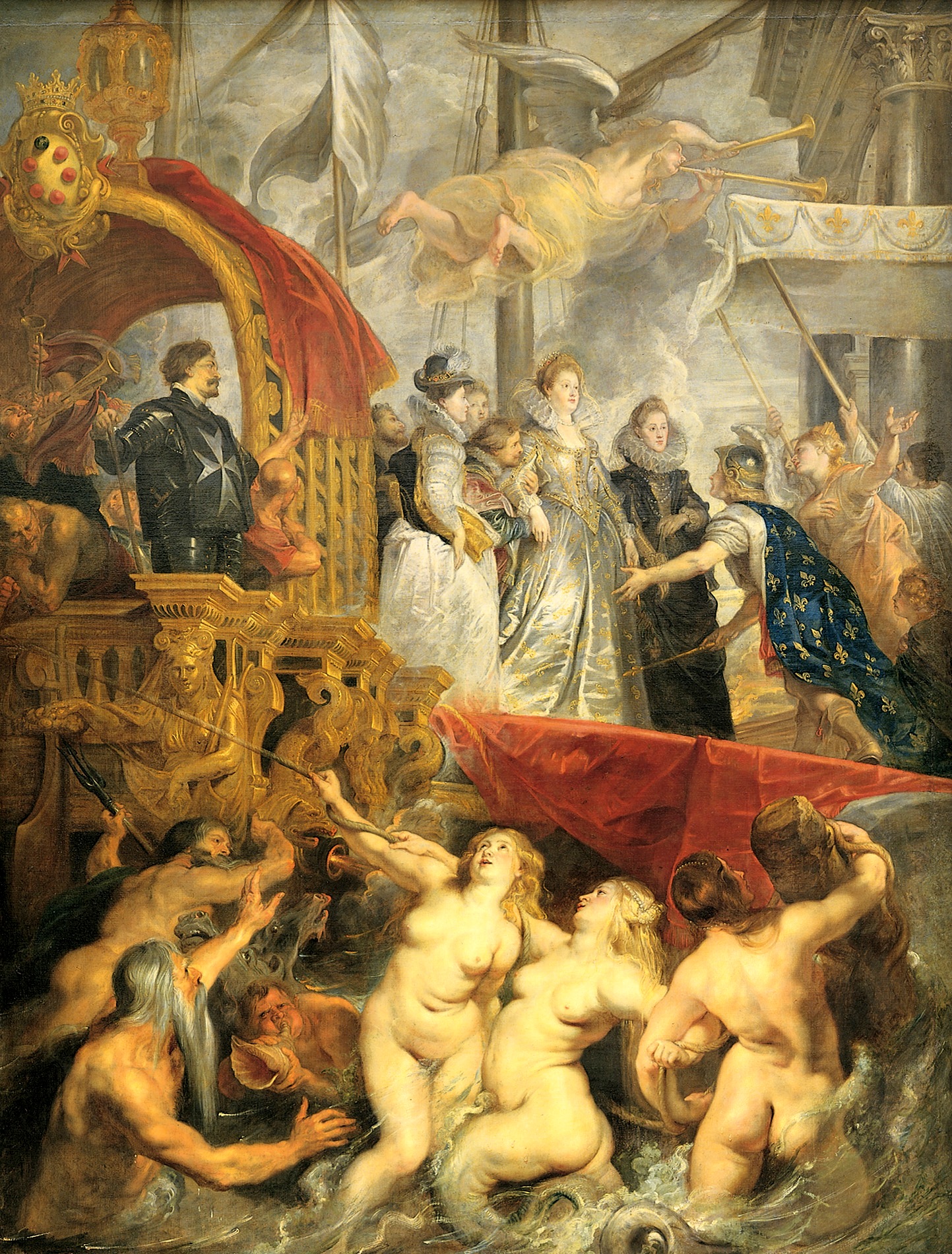
Disembarkation at Marseilles
Disembarkation at Marseilles is one of 24 canvases that comprise the Medici Cycle, commissioned for the home of Marie de Medici, the Palais du Luxembourg (which now houses the French Senate and which she called the Palais Medici), the cycle loosely depicts the life of Marie de Medici.
Start Date: 1621
Completion Date:1625
Style: Baroque
Series: The Medici Cycle
Genre: history painting
Technique: oil
Material: canvas
Dimensions: 394 x 295 cm
Gallery: Musée du Louvre, Paris, France
Point of View
Point of View:We are part of the crowd that has come to witness this historic event
FocalPoint:Maria de Medici being welcomed by the open arms of France.
Symbols & Icons
In the painting Rubens combines heaven and Earth, history and allegory into a symphony for the eyes of the viewer. Marie is welcomed to by a personified France, wearing a helmet and a blue mantle with golden fleur-de-lis.
Fame blows two horns to announce her arrival.
Neptune, three sirens, a sea-god, and a triton help escort the future Queen to her new home.
To the left, the arms of the Medici can be seen above an arched structure, where a Knight of Malta stands in all of his regalia.
Time & Motion
While Maria de Medici stands composed as the focal point of the painting, there is a flurry of activity all around her with various historical personages and Gods welcoming & celebrating the arrival. Thus creating an atmosphere of a divine arrival & giving Maria de Medici the stature of an Olympian Deity.
Composition
The rather heavy features of the Medici family, particularly evident in the Maria de Medici have been cleverly disguised, portraying her now as an Olympian Deity. Rubens ha populated his compositions with nude goddesses, pagan gods, curvaceous undines, mischievous tritons, and genii unspecified.
His contrasts are at work in the playful opposition of gleaming cuirasses and lusty bodies, fragile silks and the rugged hulls of dreadnoughts. The poverty of his subject was utterly transcended.
Avermaete discusses an interesting idea that is particularly present in this canvas.
“He [Rubens] surrounded her [Marie de’ Medici] with such a wealth of appurtenances that at every moment she was very nearly pushed into the background. Consider, for example, the Disembarkation at Marseilles, where everyone has eyes only for the voluptuous Naiads, to the disadvantage of the queen who is being received with open arms by France”
Subject Matter
Giving epic treatment to this biographical subject, Rubens was also able to give free rein to his fertile invention.All of his prodigious culture was drawn on for this works, his encyclopedic knowledge of classical mythology was exploited to the full in transforming the queen’s ordinary arrival in Marseilles after having been married to Henry IV by proxy in Florence. He depicts her leaving the ship down a gangplank accompanied by the Grand Duchess of Tuscany and her sister, the Duchess of Mantua, into the welcoming, allegorical open arms of France, evidenced by the golden fleur-de-lis on his cape of royal blue.
Related articles
- Peter Paul Rubens (taipansan.com)
- Judgement of Paris (taipansan.com)
- Daniel in the Lion’s Den (taipansan.com)




















